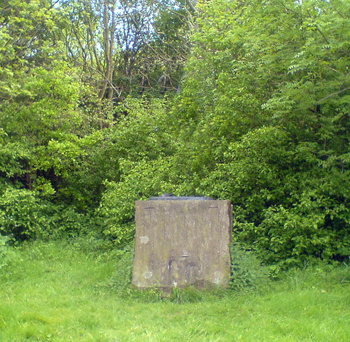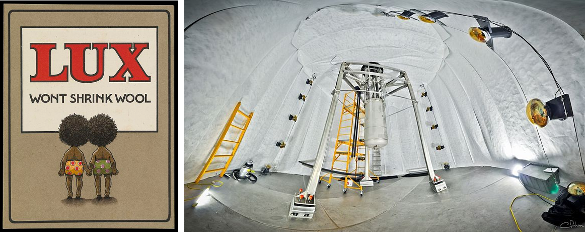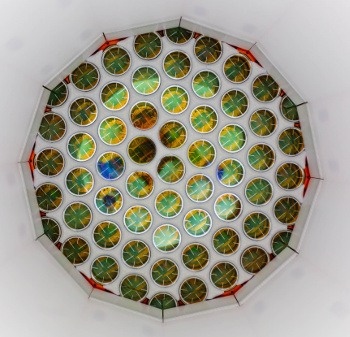Darker Matter
August 4, 2016
Svengoolie is a weekly
television show that's presented nationwide in the
US on one of the minor
cable television channels. While having other
humorous content to hold
audience attention, its intended purpose is to
broadcast the old
monster-themed films from
Universal Studios. My
wife and I have watched quite a few of these, including the many
movies based on
The Invisible Man by
H. G. Wells.

Statue of The Invisible Man.
My inspiration for this image was a lifetime of viewing New Yorker cartoons!
(Base image, Statue in Duke's Wood Commemorative Plantation, by
James Hill, via Wikimedia Commons and modified using GIMP.)
Films of this
genre can be enjoyed only with a
willing suspension of disbelief, and this is quite difficult for a
scientist. While I usually grant my
nihil obstat to quite a few
plot points in the older
science fiction films, ignoring such things as traveling to
Mars in a day using conventional
propulsion, the invisible man concept of using an
injected drug to render
invisibility is quite far-fetched.
However, current
research into invisibility through use of
metamaterials seems to indicate that a
physical device for invisibility could be forthcoming; something like an invisibility
suit. As
Arthur C. Clarke said in his
Third Law: Any sufficiently advanced
technology is indistinguishable from
magic.
Science has given visibility to many things that were once invisible, such as
atoms. As I pointed out in an
earlier article (Imaging Atoms, September 26, 2012), when we claim to "see" atoms, this is not actually true. While
optical microscopes act as
magnifiers for the
light that reaches our eyes and we see microscope images using our own eyes,
atomic force microscopes are not magnifiers of anything that can be seen. What appears on a
computer display is just a representation of atoms without a direct linkage to the
human sense of sight.
One thing in the
universe that's remained invisible for nearly a
century after the discovery of its far-reaching affect is
dark matter, previously called "missing
mass" by
astronomers. Many years ago, the
American Physical Society had a
limerick contest, and I submitted quite a few entries. I was a finalist for a limerick about
Schrödinger's cat, but one of my other submissions was about missing matter.
The accountant was ranting and hissing!
Such an audit was not of our wishing!
But such was our state,
An astronomer's fate,
Since some of our mass was found missing!
Dark matter was first inferred through observations of the
gravitational binding of
galaxies in the
Coma Cluster by astronomer,
Fritz Zwicky (1898-1974). It was Zwicky who gave dark matter its name. Current
estimates are that about 85% of the mass of the universe is dark matter; so, it's really important, and it's strange how it's never been found.
Modern
technology has now given us some unique tools in our search for dark matter, one of which is the
Large Underground Xenon experiment, also called LUX. Particle physicists are accustomed to find their matter as
subatomic particles, so LUX was designed to search for
weakly interacting massive particles (WIMPS). Such supposed particles are candidate dark matter, since they are both "massive," and "weakly interacting." I wrote about LUX in a
previous article (LUX Dark Matter Search, November 20, 2013).

We've come a long away, both in civility and technology. LUX soap products have been produced since 1899. The politically incorrect advertisement on the left was published c. 1915. The right image is the Large Underground Xenon experiment, also called LUX. (Left image, from the Wellcome Trust, image GC EPH169-L0069079, and the right image, are both via Wikimedia Commons.)
LUX is a
tank of 368
kilograms of
liquid xenon surrounded by
detectors and
shielded by a 72,000
gallon water envelope and nearly a
mile of
dirt. Xenon, an
inert gas with
atomic number 54, has many stable
isotopes with
nuclei that contain 70 or more
neutrons that give a high
interaction cross-section. Xenon is somewhat rare, existing at just 0.087
parts-per-million by
volume in
Earth's atmosphere.
LUX is located in a
laboratory 4,850 ft underground, the
Sanford Underground Research Facility,
Lead, South Dakota. This is the same underground site where
Ray Davis did
his experiment on
solar neutrinos. I wrote about the Davis experiment in a
previous article (Bacterial Iron Isotopes, July 22, 2013).
The LUX team presented their final report at the
Identification of Dark Matter 2016 Conference (IDM2016, July 18-22, 2016).[1-2] They summarized their
data from October, 2014, through May, 2016, that showed not a single WIMP. This
null result was despite the fact that the
sensitivity of LUX was four times that of its original
design.[1] Said
Rick Gaitskell, a
professor of
physics at
Brown University and
co-spokesperson for the LUX experiment,
"LUX has delivered the world's best search sensitivity since its first run in 2013... With this final result from the 2014 to 2016 search, the scientists of the LUX Collaboration have pushed the sensitivity of the instrument to a final performance level that is four times better than the original project goals. It would have been marvelous if the improved sensitivity had also delivered a clear dark matter signal. However, what we have observed is consistent with background alone"[1]

As pretty as a work of art.
The LUX photodetectors are capable of detecting a single photon.
(Image by Matt Kapust, Sanford Underground Research Facility, via Brown University.)
The sensitivity was measured by simulating WIMPs with a beam of
neutrons, and also by using
radioactive gases to find how well the detectors could distinguish between a WIMP signal and the ambient
radioactivity that's always present in
Earth's crust.[1]
Simon Fiorucci, a
physicist at
Lawrence Berkeley National Laboratory and science coordination
manager for the experiment, emphasized that "The result is unambiguous data we can be proud of and a timely result in this very competitive field - even if it is not the positive detection we were all hoping for."[1]
The WIMP search will continue after LUX with the
LUX-ZEPLIN (LZ) experiment, also sited at the Sanford Underground Research Facility. LUX-ZEPLIN will contain ten
tons of liquid xenon, about thirty times the xenon of LUX. LUX-ZEPLIN will reside inside the same radiation shield of 72,000-gallons of water used by LUX.[1] LUX was funded by the
U.S. Department of Energy Office of Science, and the
National Science Foundation. The
collaboration included twenty
research universities and
national laboratories in the United States, the
United Kingdom, and
Portugal.[1]
References:
- Kevin Stacey, "World's most sensitive dark matter detector completes search," Brown University Press Release, July 21, 2016.
- Katyanna Quach, "Nope, we can't find dark matter either, says LUX team," The Register (UK), July 21, 2016.
- Large Underground Xenon dark matter experiment web site.
Permanent Link to this article
Linked Keywords: Svengoolie; television show; United States; cable television channel; humour; humorous; audience; broadcast; monster-themed films; Universal Studios; wife; film; movie; The Invisible Man; H. G. Wells; statue; artistic inspiration; The New Yorker; cartoon; James Hill; GIMP; genre; willing suspension of disbelief; scientist; nihil obstat; plot point; science fiction; Mars; propulsion; injection; injected; pharmaceutical drug; invisibility; research; metamaterial; physics; physical; suit; Arthur C. Clarke; Clarke's Third Law; technology; magic; science; atom; optical microscope; magnification; magnifier; light; atomic force microscope; computer monitor; computer display; visual perception; human sense of sight; universe; century; dark matter; mass; astronomer; American Physical Society; limerick; competition; contest; Schrödinger's cat; accountant; audit; gravitation; gravitational binding; galaxy; Coma Cluster; Fritz Zwicky (1898-1974); approximation; estimate; Large Underground Xenon experiment; subatomic particle; weakly interacting massive particle; civility; Lux soap; soap; political correctness; politically incorrect; advertising; advertisement; Wellcome Trust; Wikimedia Commons; storage tank; kilogram; liquid; xenon; photodetector; radiation protection; shield; gallon; water; mile; dirt; inert gas; atomic number; isotope; atomic nucleus; neutron; interaction cross-section; parts-per-million; volume; atmosphere of Earth; laboratory; Sanford Underground Research Facility; Lead, South Dakota; Raymond Davis Jr.; Ray Davis; Homestake experiment; solar neutrino problem; Identification of Dark Matter 2016 Conference; data; null result; sensitivity; design; Rick Gaitskell; professor; physics; Brown University; spokesperson; photon; Matt Kapust; radioactive decay; radioactive; gas; radioactivity; Earth's crust; Simon Fiorucci; physicist; Lawrence Berkeley National Laboratory; manager; LUX-ZEPLIN (LZ) experiment; ton; U.S. Department of Energy; Office of Science; National Science Foundation; collaboration; research institute; research university; national laboratories in the United States; United Kingdom; Portugal.